Abdominal Coning During Pregnancy-The Cause and Solution
(This post probably contains affiliate links. I receive a small commission at no cost to you through links shared on this website to help keep the information I provide free to you)
Coning, doming, diastasis OH MY!
These buzzwords have made a huge appearance in the pregnancy and new mom world over the last couple of years.
But with awareness often comes mixed messages which can lead to a lot of confusion, frustration and helplessness.
One common concern that pregnant women face is something called “coning”, or the appearance of a cone-shaped bulge that forms down the midline of the abdomen during certain movements or exercises.
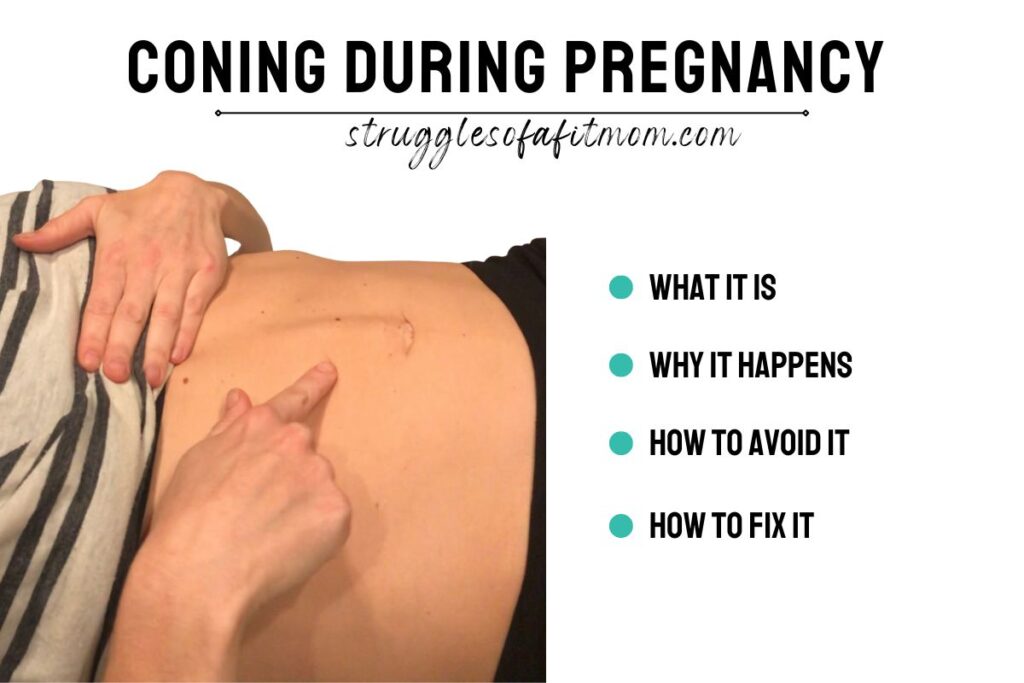
While this may be alarming, the good news is that it is a completely normal and natural process of pregnancy.
Today we are going to chat about what this protrusion means, why it happens and how to manage it to protect your core during pregnancy.
So let’s explore coning, doming and diastasis recti (DR) shall we?
(Disclaimer: Although I am a certified prenatal/postnatal exercise specialist and personal trainer, I am not YOUR trainer. The content on this blog is for informational purposes only and should not be a substitute of the information and advice you receive from a healthcare professional.
What is Coning or Doming of The Abdomen During Pregnancy?
“Coning” or “doming” are the terms often used to describe the linear ridge that protrudes down the midline of the abdomen during certain movements or exercises.
These movements include planking, push-ups, pul-ups, overhead extensions and crunching movements.
This ridge-like protrusion is a sign that the rectus abdominis muscles (aka six-pack muscles) have begun stretching and widening to make room for your growing baby.
But don’t freak out!
The abdominal muscles MUST SEPARATE to make room for your baby.
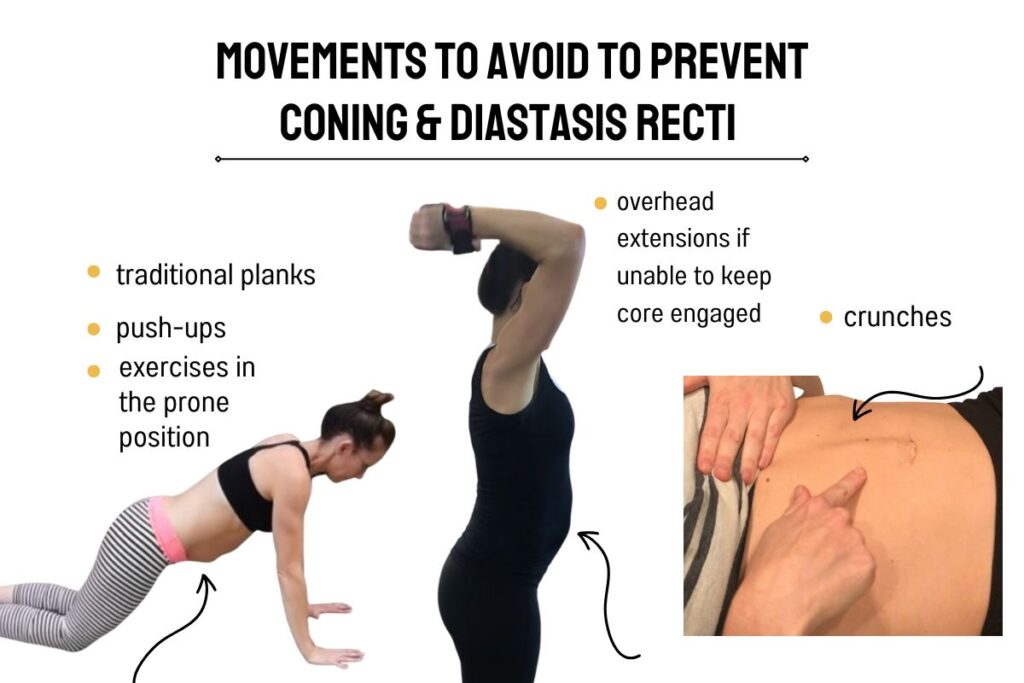
What Causes Abdominal Coning During Pregnancy?
During pregnancy, the rectus abdominis muscles widen and separate in order to accommodate the growing uterus.
While this may sound scary, it is a completely normal, natural and necessary part of pregnancy.
Separation of the abdominal muscles is what allows your baby to grow!
The two sides of the rectus abdominis muscles are connected by a thin band of connective tissue called the “linea alba”.
As your baby grows, this connective tissue stretches to allow the rectus muscles to essentially “get out of the way” for the growing baby.
As it stretches, it also becomes thinner.
During movements that increase what’s called “intra-abdominal pressure”, the internal organs can protrude against the linea alba causing a ridge or cone shape down the middle of your belly.
Coning usually becomes more pronounced in the third trimester as the baby grows and the connective tissue becomes thinner but you may notice it in the second trimester if this is not your first pregnancy.
Related: Best Ab Workouts During Pregnancy [To Prevent A Pooch]
Is Abdominal Coning Normal?
Coning is very common condition during pregnancy and I would even go as far as to say that it is normal.
However, normal and common do not necessarily mean ideal.
While coning is a part of pregnancy, that does not mean it should be ignored or left untreated.
If ignored, coning and abdominal separation can lead to further issues such as damage to the linea alba, incontinence, pelvic floor dysfunction and prolapse.
Therefore, it is important to be aware of the signs and symptoms of coning and abdominal separation to prevent further compromising the integrity of the connective tissue and strength of core, pelvic floor.
Is Coning Bad?
It is not necessarily “bad” but it should be avoided as much as possible.
If the tissue that connects the rectus abdominis muscles is compromised, our core cannot handle excessive force within our abdominal cavity and these movements are going to either generate force down onto the pelvic floor muscles or out against the linea alba.
The linea alba is like a rubber band. If it gets stretched too much or too often, it may not ever return to its normal state.
Repetitive stress against the lina alba or pelvic floor can lead to long term risks such as:
- pelvic floor pain and or dysfunction
- incontinence
- prolapse
- hernias
Our core needs to be able to regulate the pressure generated in the abdominal cavity when we perform movements such as coughing, sneezing, laughing, going to the bathroom, lifting something heavy or even just getting out of bed.
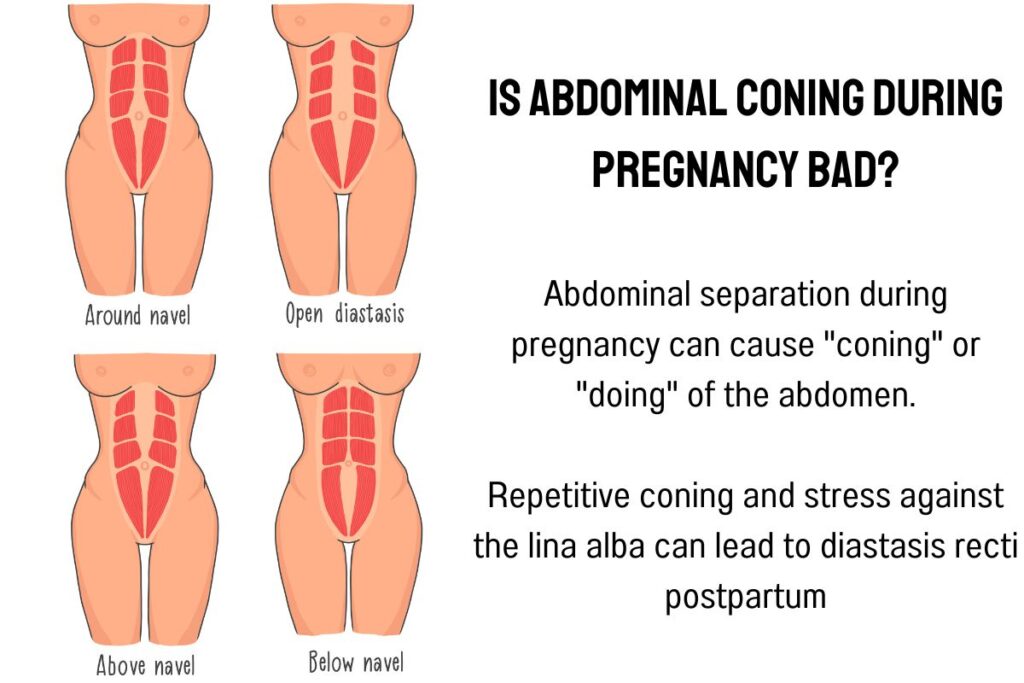
What are the Risks Associated with Coning During Pregnancy?
Coning is a sign of abdominal muscle separation, which can lead to a condition called “diastasis recti abdominis”.
Diastasis recti is when the connective tissue between the two sides of the rectus abdominis muscle becomes over stretched and essentially damaged.
The side effects of diastasis recti can be challenging to manage, painful and even affect your daily activities.
Common symptoms of coning or abdominal separation during pregnancy are:
- lower back pain
- pelvic pain
- pelvic organ prolapse
- incontinence or fecal incontinence
- in severe cases it can cause possible hernia
Does Coning Mean I Have Diastasis Recti?
Not necessarily and this is where the messages get a little cloudy.
Abdominal separation and diastasis recti are not the same thing.
Abdominal separation is a normal and natural process during pregnancy.
It occurs when the a two halves of the rectus abdominis muscles separate at the linea alba.
Diastasis recti, on the other hand, is a condition where the connective tissue between the two sides of the rectus abdominis muscle becomes overstretched and damaged.
It is not diagnosed until 2-3 months postpartum when the connective tissue has had a chance to heal on its own.
If this is your first pregnancy, it is likely too soon to assume that you have diastasis recti.
However, two risk factors for diastasis recti are multiple pregnancies and repetitive coning and strain on the linea alba.
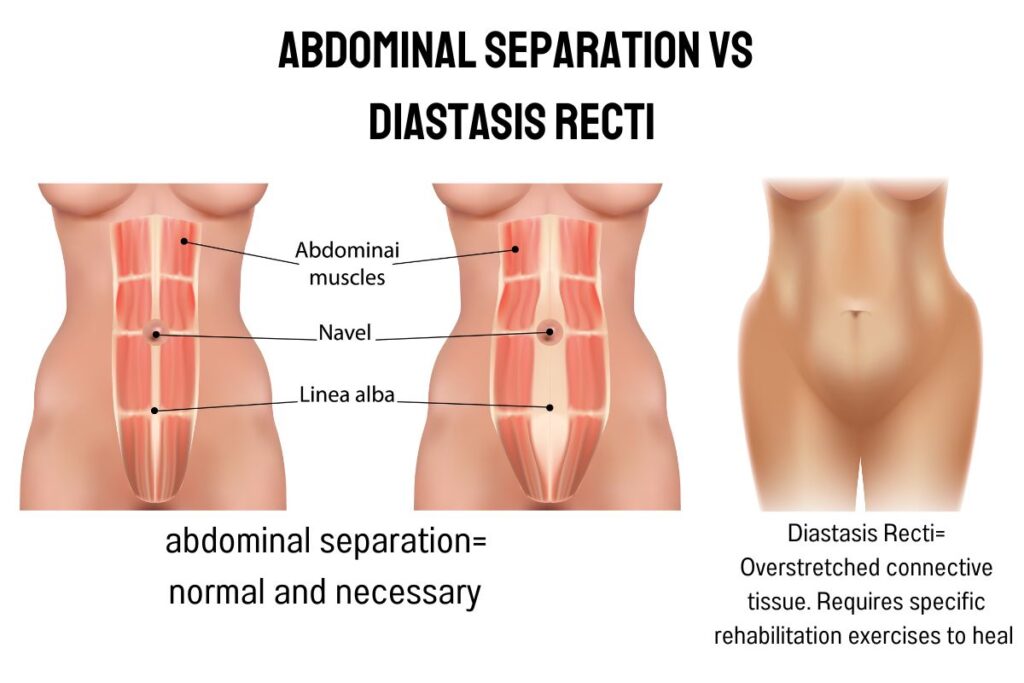
How Do I Know if I Have Coning During Pregnancy?
Coning looks like a ridge down the midline of your abdomen.
It is more prominent during certain activities such as getting up out of bed or lifting something heavy.
Another way to see if you have coning is to check yourself for abdominal separation.
This is a simple test you can do:
- Lie on your back with your knees flat on the ground in a sit-up position
- Place one hand behind your head and the other on your abdomen.
- On an exhale, perform a small crunch
- Use your hand to palpate your fingers up and down the midline of your core. Do you notice a protrusion down the midline of your core that feels like a pointy bump or ridge?
- Now use your fingers to measure the distance of the gap you feel between the two hemispheres of the ab muscles. The degree of separation is measured by finger widths. Ab separation greater than two finger width is considered possible diastasis recti.
Crunching increases intra-abdominal pressure.
If you notice a pointy ridge down the middle of your stomach, it’s a sign your abdominal muscles have separated and the core muscles have become inefficient at regulating the pressure against the linea alba.
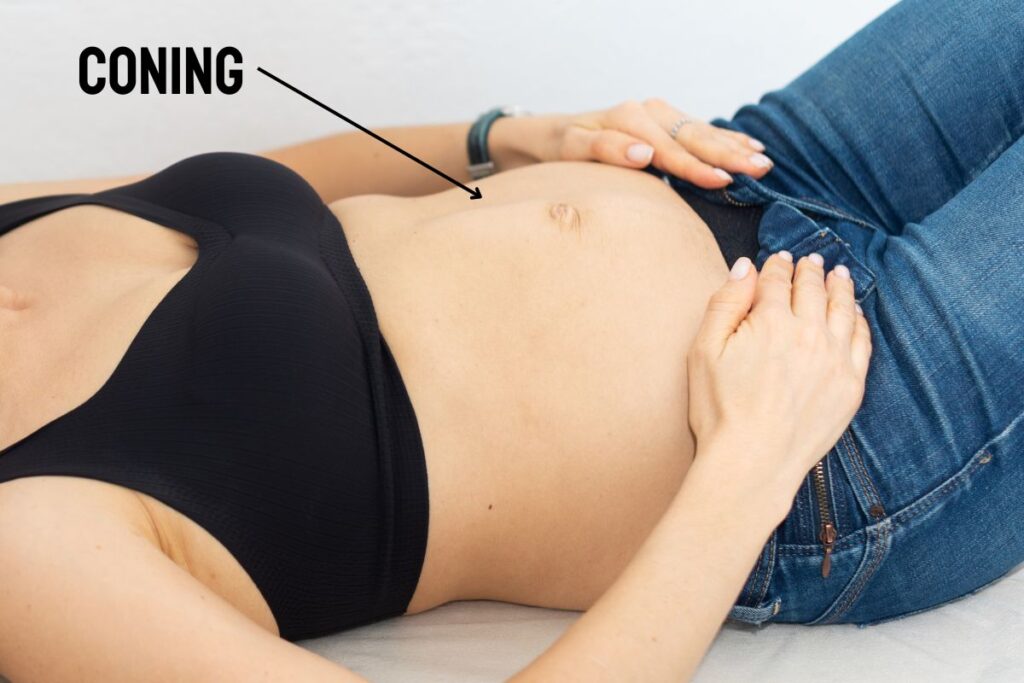
How Can I Prevent Coning During Pregnancy?
Despite what you may hear or read on social media, it is impossible to prevent abdominal separation during pregnancy.
However, the good news is there are things you can do to minimize coning during pregnancy and lower your risk of developing diastasis recti postpartum.
By following the steps below, you can help to keep your core muscles strong during pregnancy.
- Avoid
- sit-ups, crunches, and traditional planks
- pull-ups and traditional push-ups after the first trimester
- breath holding
- Be mindful of sitting up from lying down. This crunching movement can cause coning.
- Minimize excess weight gain
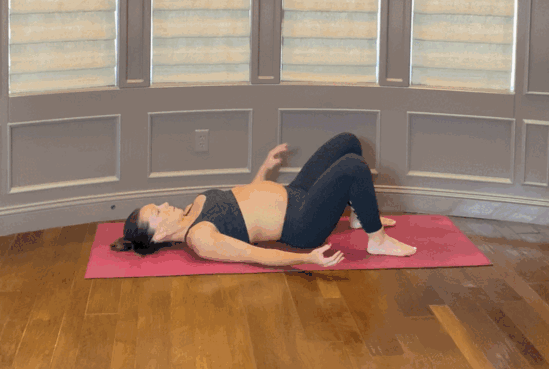
5 Prenatal Core Exercises To Prevent Coning During Pregnancy
The best way to avoid coning during pregnancy is to strengthen your deep core muscles, specifically the transverse abdominis muscle.
This muscle is the innermost layer of your abdominal muscles and acts like a corset, wrapping around your midsection to provide support for your spine.
When this muscle is strong, it can help to stabilize your spine and pelvis, and prevent coning during pregnancy.
Here are 5 exercises you can do to strengthen your transverse abdominis muscle:
Diaphragmatic breathing
Pregnancy causes changes in breathing patterns. This can cause improper management of intra-abdominal pressure and place stress on the linea alba and pelvic floor.
Simply learning how to re-pattern your breath can help keep your core strong and functional.
- Start by lying on your back with your knees bent and feet flat on the ground. You may also do this sitting on the edge of a chair or exercise ball.
- Place one hand on your stomach and the other on your outer ribcage. Hand placement is important because it will help guide your breath.
- Slowly inhale through your nose, allowing your ribcage to expand laterally against the hand that is resting on your ribcage.
- As you continue taking a deep inhale, you should focus on allowing your pelvic floor and core to relax and expand.
- Slowly begin exhaling, and “reversing” your breath. As your belly draws in and your rib cage sinks down, think about slowly contracting and lifting the pelvic floor muscles and engaging the core to press the air back up toward your ribcage.
- Repeat for a total of at least ten breaths.
Exercise Tips
- To get the most out of the relaxation benefits diaphragmatic breathing, inhale for 4 seconds and exhale for 8 seconds.
- Close your eyes and visualize your pelvic floor opening like a flower blossoming and closing like you are lifting a blueberry with your pelvic floor.
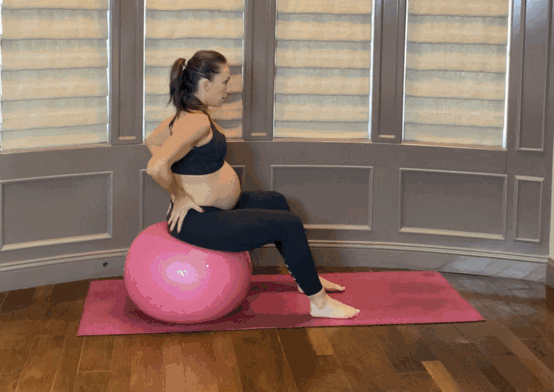
Bird dog
- Start in a tabletop position with your shoulders over your wrists and your hips over your knees.
- Inhale and on the exhale, engage your core and extend your right arm in front of you and your left leg straight behind you.
- Maintain a flat back as you reach your arms and leg straight so that they are parallel to the floor. Avoid extending your arm and leg high than your back.
- If your back begins to arch, lower your leg or rest your toes on the ground.
- Hold for three slow counts then return to starting position. Repeat on the other side.
Exercise Tips
- Use your core to prevent your hips from dropping side to side as you lift your arm and leg.
- Engage your glute to hold your leg out straight.
- Focus on preventing your lower back from arching as you extend your arm and leg.

Pelvic Tilts
Every mom feels activation in their core a little differently. You can do pelvic tilts in several different positions to find one that helps you feel your core the most.
Standing position
- Start by standing with your back against a wall and your feet shoulder-width apart. Your heels should be about 6-inches from the wall and maintain a slight bend in your knees.
- Place your fingers in a diamond position around your belly button and imagine you are rolling a marble from the top of the diamond to the bottom by using your core muscles.
- Inhale to relax you core and pelvic floor. Imagine the marble rolling to the bottom of your finger tips.
- Slowly exhale while engaging your core to slowly tilt your pelvis under, so that your low back presses against the wall. Imagine rolling the marble to the tops of your thumbs
- Hold for a count of five and on an inhale, slowly release the tilt and return to starting position.
- This position with the marble at the top of your thumbs is what you want to be able to hold while performing other movements.
Exercise notes
- This movement can also be done in a table top position or on your back.
- If you struggle to feel your deep core muscles, you can place a small ball or pilates ball between your knees.
- On your exhale, gently squeeze the ball between your knees as you tilt your pelvis. This will help activate your deep core muscles and pelvic floor.
Exercise Tips
- Avoid arching your back or holding your breath.
- Keep the movements small and controlled.
- Think lifting your pelvic floor and drawing your navel up and slightly in.

Bell Hovers
Finding and feeling your transverse abdominis muscles can take some practice.
It is a good idea to practice engaging the core in different positions and this is a great option to help improve mind-muscle connection.
- Start on your hands and knees with your shoulders over your wrists and hips over your knees.
- Keep a neutral spine and on an exhale, engage your core muscles and imagine zipping up your core from navel to rib cage as lift your knees about an inch off the ground.
- Hold this position for 5-10 seconds then slowly lower back to the starting position.
- Repeat for 12-15 reps
Exercise Tips
- If you are having trouble feeling your transverse abdominis muscle, try placing a small yoga ball between your knees and gently squeeze the ball as you lift your knees off the ground.

Incline Plank
Traditional planks may be a no-go during pregnancy, but when done with certain modifications, they can be a great exercise to strengthen the core and relieve low back pain.
- Begin by placing your palms on an elevated surface such as a kitchen counter, the edge of a couch, a chair or a workout bench.
- On an exhale, engage your core and step back into a plank position with your body in a straight line from head to toe.
- Press your hands firmly into the surface and draw your shoulders down away from your ears.
- Engage your core and hold this position for 20-40.
- Imagine hugging and lifting your baby with your core muscles.
Exercise Tips:
- The incline takes some pressure off the core and low back while still allowing you to work your core muscles.
- To make this exercise more challenging, lift one leg at a time or alternate lifting each arm while maintaining a level pelvis. If you lift your legs, avoid arching your back.

Other Common Questions About Coning During Pregnancy
Below are some other frequently asked questions about coning.
Does Coning Go Away After Pregnancy? How Long Will It take?
For most women, coning during pregnancy will resolve itself after delivery.
If you have diastasis recti, however, the condition will not improve on its own and will require specific rehabilitation exercises to heal properly.
One of the biggest problems in healing abdominal separation after pregnancy is that many doctors do not screen for this at their postpartum follow up appointments.
They are cleared to resume exercise at their postpartum check up but they are not given guidelines of where to start or exercises to avoid.
Taking charge of your own postpartum rehabilitation is your best chance and prevent severe diastasis.
Related: 6 Exercises to Heal The Lingering Postpartum Belly Pooch
Should I Worry About Diastasis Recti During Pregnancy?
Diastasis recti should definitely be on your radar but nothing to panic about.
The best way to prevent diastasis recti is to be aware of things that can increase stress on the linea alba coning and take steps to avoid it.
Prenatal core strengthening exercises will help keep your deep abdominal muscles strong to minimize stress on the connective tissue as well as help you heal faster after delivery.
Can You Prevent Diastasis Recti During Pregnancy?
Avoiding coning or doming of the abdomen is the best way to reduce the degree of abdominal separation which can lead to diastasis recti.
You cannot prevent the abdominal muscles from separating during pregnancy.
However, you CAN minimize movements that create coning, and you can strengthen your deep core muscles to help protect the integrity of the linea alba to prevent diastasis recti.
Related: Best Ab Exercises During Pregnancy [26 Best Exercises]
What Are The Risks Of Not Treating Diastasis Recti?
Let’s put it this way.
If you injured your knee or shoulder, would you just ignore it and hope it gets better on its own?
Of course not!
The same goes for diastasis recti.
If left untreated, diastasis recti can lead to chronic lower back pain, hernias, pelvic floor issues, incontinence and a pooch that you can’t seem to get rid of despite diet and exercise.
Treating diastasis recti requires targeted exercises that help to close the gap in the abdominal muscles and restore function to the core.
Final thoughts on abdominal coning during pregnancy
Abdominal coning during pregnancy create repetitive stress on the linea alba which can cause diastasis recti postpartum or in future pregnancies.
Taking steps to avoid coning and strengthening the core muscles can help prevent diastasis recti and other related problems.
You can manage coning by being aware of movements that make it worse and by avoiding them.
If coning is severe or causes pain, talk to your healthcare provider.
And finally, don’t be afraid to work your core during pregnancy! This is the best way to prevent severe coning or diastasis recti.
FACT CHECK
Struggles of a Fit Mom uses only high-quality sources, including peer-reviewed studies, to support the facts within it’s articles. Read my editorial process to learn more about how I fact-check and keep my content accurate, reliable, and trustworthy.
Diastasis Recti (Abdominal Separation): Symptoms & Treatment. (n.d.). Cleveland Clinic. https://my.clevelandclinic.org/health/diseases/22346-diastasis-recti
Sperstad, J. B. (2016, September 1). Diastasis recti abdominis during pregnancy and 12 months after childbirth: prevalence, risk factors and report of lumbopelvic pain. British Journal of Sports Medicine. https://bjsm.bmj.com/content/50/17/1092

Brooke is a certified Prenatal and Postnatal Exercise Specialist with a Bachelors of Science degree in Kinesiology-Exercise Science. She is also a mom of 3 girls with more than 15 years of experience in health and fitness. Brooke’s goal at Struggles of a Fit Mom is to help motivate, educate and inspire other busy mamas who struggle with finding time, energy and motivation to take care of themselves in the chaos of motherhood.







